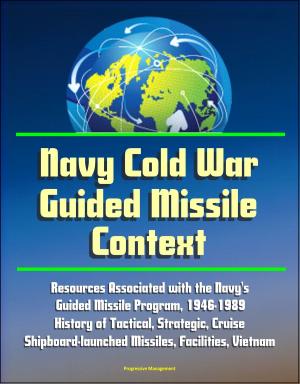21st Century U.S. Military Manuals: Multi-Service Tactics, Techniques, and Procedures for Conducting Peace Operations - FM 3-07.31 (Value-Added Professional Format Series)
Nonfiction, History, Military, Social & Cultural Studies, Political Science| Author: | Progressive Management | ISBN: | 9781465791887 |
| Publisher: | Progressive Management | Publication: | September 10, 2011 |
| Imprint: | Smashwords Edition | Language: | English |
| Author: | Progressive Management |
| ISBN: | 9781465791887 |
| Publisher: | Progressive Management |
| Publication: | September 10, 2011 |
| Imprint: | Smashwords Edition |
| Language: | English |
Part of our value-added professional format series, the Multi-Service Tactics, Techniques, and Procedures for Conducting Peace Operations Field Manual (FM 3-07.31) covers peacekeeping operations and related functions of the military, including the UN operations, the enforcement of sanctions, and humanitarian assistance. This FM has been converted for accurate flowing-text e-book format reproduction.
In the preface, it states: "This manual provides guidance for the full range of peace operations, to include support to diplomacy (peacemaking, peace building, and preventive diplomacy), peacekeeping (PK), and peace enforcement (PE). It addresses the environment of peace operations, related concepts, principles, and fundamentals, to include planning, operational considerations, training, and supporting functions. This manual is for commanders and staffs charged with the responsibility for peace operations to assist them in planning and conducting operations. It is also useful to nonmilitary agencies and foreign military units conducting related operations. This manual supports soldiers and leaders who execute peace operations. It serves as the foundation for further development of US Army tactics, techniques, and procedures (TTPs) manuals and refinement of existing training support packages (TSPs), mission training plans (MTPs), training center and unit exercises, and service school curricula. It drives the examination of organizations and materiel developments applicable to peace operations. Commanders will face ambiguous situations and uncertainty in peace operations. They are obligated to set clear objectives, define the mission, firmly guide operations, and measure progress and success. In order to assist commanders and their staffs, this manual explains the principles and tenets of peace operations and their applications; describes likely peace operations; and discusses command, control, coordination, and liaison requirements and other unique planning considerations. It also provides information concerning the UN and other organizations that may participate in peace operations. This manual incorporates lessons learned from recent peace operations and existing doctrine to provide a framework for development in the conduct of peace operations. The basis of this manual is the US Army's expertise in conducting missions on land as a demonstration of US resolve and commitment to international peace, security, and stability. It provides guidelines for implementation of deterrence and compellance measures during peace operations in support of US National Security Strategy (NSS), National Military Strategy (NMS), and US policy."
FUNDAMENTALS OF PEACE OPERATIONS - The Strategic Context, The Types of Operations, The Variables, The Principles, The Tenets
COMMAND, CONTROL, COORDINATION, AND LIAISON - Command and Support Relationships, Unilateral Operations, Multinational Operations, United Nations Operations, Non-United Nations Operations, Humanitarian Assistance, Interagency Operations, Liaison
PLANNING CONSIDERATIONS - Mission Analysis, Campaign Plan, Use of Force, Force Protection, Force Training, Force Tailoring, Combat Functions, Public Affairs Considerations, Legal Considerations
LOGISTICS - Preparation-of-the Theater, Shared Logistics, Resource Management, Logistics Functions
As a bonus, this reproduction includes FM-1, The Army Field Manual, a capstone manual containing the vision for the Army - sold separately for $5.99. FM 1 establishes the fundamental principles for employing Landpower. The most important of these are the Army's operational concept and the fundamentals that support it. They form the foundation for all Army doctrine. All Soldiers should understand and internalize them. FM 1 describes the American profession of arms, the Army's place in it, and what it means to be a professional Soldier.
This is a privately authored news service and educational publication of Progressive Management.
Part of our value-added professional format series, the Multi-Service Tactics, Techniques, and Procedures for Conducting Peace Operations Field Manual (FM 3-07.31) covers peacekeeping operations and related functions of the military, including the UN operations, the enforcement of sanctions, and humanitarian assistance. This FM has been converted for accurate flowing-text e-book format reproduction.
In the preface, it states: "This manual provides guidance for the full range of peace operations, to include support to diplomacy (peacemaking, peace building, and preventive diplomacy), peacekeeping (PK), and peace enforcement (PE). It addresses the environment of peace operations, related concepts, principles, and fundamentals, to include planning, operational considerations, training, and supporting functions. This manual is for commanders and staffs charged with the responsibility for peace operations to assist them in planning and conducting operations. It is also useful to nonmilitary agencies and foreign military units conducting related operations. This manual supports soldiers and leaders who execute peace operations. It serves as the foundation for further development of US Army tactics, techniques, and procedures (TTPs) manuals and refinement of existing training support packages (TSPs), mission training plans (MTPs), training center and unit exercises, and service school curricula. It drives the examination of organizations and materiel developments applicable to peace operations. Commanders will face ambiguous situations and uncertainty in peace operations. They are obligated to set clear objectives, define the mission, firmly guide operations, and measure progress and success. In order to assist commanders and their staffs, this manual explains the principles and tenets of peace operations and their applications; describes likely peace operations; and discusses command, control, coordination, and liaison requirements and other unique planning considerations. It also provides information concerning the UN and other organizations that may participate in peace operations. This manual incorporates lessons learned from recent peace operations and existing doctrine to provide a framework for development in the conduct of peace operations. The basis of this manual is the US Army's expertise in conducting missions on land as a demonstration of US resolve and commitment to international peace, security, and stability. It provides guidelines for implementation of deterrence and compellance measures during peace operations in support of US National Security Strategy (NSS), National Military Strategy (NMS), and US policy."
FUNDAMENTALS OF PEACE OPERATIONS - The Strategic Context, The Types of Operations, The Variables, The Principles, The Tenets
COMMAND, CONTROL, COORDINATION, AND LIAISON - Command and Support Relationships, Unilateral Operations, Multinational Operations, United Nations Operations, Non-United Nations Operations, Humanitarian Assistance, Interagency Operations, Liaison
PLANNING CONSIDERATIONS - Mission Analysis, Campaign Plan, Use of Force, Force Protection, Force Training, Force Tailoring, Combat Functions, Public Affairs Considerations, Legal Considerations
LOGISTICS - Preparation-of-the Theater, Shared Logistics, Resource Management, Logistics Functions
As a bonus, this reproduction includes FM-1, The Army Field Manual, a capstone manual containing the vision for the Army - sold separately for $5.99. FM 1 establishes the fundamental principles for employing Landpower. The most important of these are the Army's operational concept and the fundamentals that support it. They form the foundation for all Army doctrine. All Soldiers should understand and internalize them. FM 1 describes the American profession of arms, the Army's place in it, and what it means to be a professional Soldier.
This is a privately authored news service and educational publication of Progressive Management.















